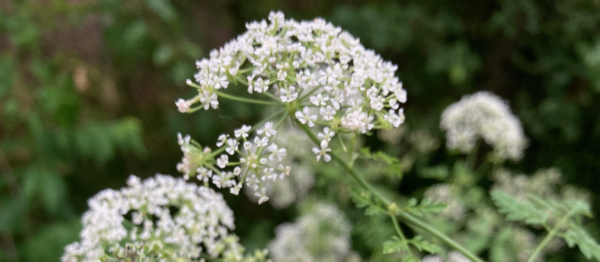
Why Is It Called “Poison Hemlock”?
Conium maculatum, commonly called “poison hemlock” is a biennial herb in the carrot family. It is extremely poisonous and sometimes deadly to humans and animals. Poison hemlock is not the same plant as water hemlock, however, both are deadly. Water hemlock or Cicuta douglasii is actually even more deadly but tends to grow in smaller patches only by water. Hemlock has been referred to as “the deadliest plant in North America”. Ingesting any part of the plant can kill, and even touching the plant can cause allergic reaction.
Poison hemlock can kill livestock if as little as 100-300 grams are ingested. Animals can die from respiratory failure approximately three hours after ingesting the plant.
The alkaloids found in hemlock will target the neuro-muscular systems in the body and shut down their connections, including the breathing muscles which is what makes them so dangerous. Ingesting any part of the poison hemlock plant can cause vomiting, seizures, kidney failure, and respiratory failure. There is no antidote for the poisoning, either. However, prompt treatment in a hospital can typically manage the symptoms until the poison is fully gone.
Hemlock can sometimes be confused with the edible wild carrot, Queen Anne’s Lace, parsley, or wild parsnip plants. All of these plants may have similar leaves and similar looking flower heads. All are in the carrot plant family Apiaceae. This makes accidental poisonings more common. The plants also tend to grow in similar areas in pastures, ditches, fence lines, and fields. I have seen Queen Anne’s Lace growing side-by-side with poison hemlock.
Morphology
Here is some morphology to help you know how to identify the poison hemlock plant.
The base stems of the poison hemlock do not have hairs, are smooth, and may have reddish or purplish splotches. Most of its look-alikes will have hairs on the stems and no colored splotches. The wild parsley plant will have shallow grooves on its stem but the poison hemlock plant only has smooth stems.
The flower heads of the poison hemlock are branching into multiple umbels, or umbrella shaped clusters of flowers, on multiple stems. The flowers are white. Wild Parsnip flowers are yellow. Queen Anne’s Lace or Wild Carrot flowers are white but their flower heads are more tightly clustered than the hemlock’s.
As always, do your due diligence and do not eat wild plants unless you know for sure what they are, especially ones in the Apiaceae family!
If you enjoyed this plant profile on poison hemlock, check out this one on dandelions. Although dandelions may be bothersome weeds for gardeners, they are a much more friendly plant than hemlock, and they are an edible wild plant.

